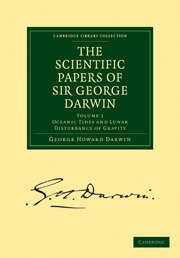Book contents
- Frontmatter
- PREFACE
- Contents
- Chronological List of Papers with References to the Volumes in which they probably will be contained
- PART I OCEANIC TIDES
- ART. 1 The Harmonic Analysis of Tidal Observations
- ART. 2 On the Periods Chosen for Harmonic Analysis, and a Comparison with the Older Methods by means of Hour-angles and Declinations
- ART. 3 Datum Levels: the Treatment of a Short Series of Tidal Observations and on Tidal Prediction
- ART. 4 A General Article on the Tides
- ART. 5 On the Harmonic Analysis of Tidal Observations of High and Low Water
- ART. 6 On an Apparatus for Facilitating the Reduction of Tidal Observations
- ART. 7 On Tidal Prediction
- ART. 8 On the Correction to the Equilibrium Theory of Tides for the Continents
- ART. 9 Attempted Evaluation of the Rigidity of the Earth from the Tides of Long Period
- ART. 10 Dynamical Theory of the Tides
- ART. 11 On the Dynamical Theory of the Tides of Long Period
- ART. 12 On the Antarctic Tidal Observations of the ‘Discovery’
- PART II THE LUNAR DISTURBANCE OF GRAVITY
- INDEX
- Plate section
ART. 2 - On the Periods Chosen for Harmonic Analysis, and a Comparison with the Older Methods by means of Hour-angles and Declinations
Published online by Cambridge University Press: 07 September 2010
- Frontmatter
- PREFACE
- Contents
- Chronological List of Papers with References to the Volumes in which they probably will be contained
- PART I OCEANIC TIDES
- ART. 1 The Harmonic Analysis of Tidal Observations
- ART. 2 On the Periods Chosen for Harmonic Analysis, and a Comparison with the Older Methods by means of Hour-angles and Declinations
- ART. 3 Datum Levels: the Treatment of a Short Series of Tidal Observations and on Tidal Prediction
- ART. 4 A General Article on the Tides
- ART. 5 On the Harmonic Analysis of Tidal Observations of High and Low Water
- ART. 6 On an Apparatus for Facilitating the Reduction of Tidal Observations
- ART. 7 On Tidal Prediction
- ART. 8 On the Correction to the Equilibrium Theory of Tides for the Continents
- ART. 9 Attempted Evaluation of the Rigidity of the Earth from the Tides of Long Period
- ART. 10 Dynamical Theory of the Tides
- ART. 11 On the Dynamical Theory of the Tides of Long Period
- ART. 12 On the Antarctic Tidal Observations of the ‘Discovery’
- PART II THE LUNAR DISTURBANCE OF GRAVITY
- INDEX
- Plate section
Summary
RECORD OF WORK DURING THE PAST YEAR.
A large number of tidal results have been obtained by the United States Coast Survey, and reduced under the superintendence of Professor Ferrel. Although the method pursued by him has been slightly different from that of the British Association, it appears that the American results should be comparable with those at the Indian and European ports. Professor Ferrel has given an assurance that this is the case; nevertheless, there appears to be strong internal evidence that, at some of the ports, some of the phases should be altered by 180°.
CERTAIN FACTORS AND ANGLES USED IN THE REDUCTION OF TIDAL OBSERVATIONS.
[These are given at the end of the last Paper.]
ON THE PERIODS CHOSEN FOR HARMONIC ANALYSIS IN THE COMPUTATION FORMS.
Before proceeding to the subject of this section, it may be remarked that it is unfortunate that the days of the year in the computation forms should have been numbered from unity upwards, instead of from zero, as in the case of the hours. It would have been preferable that the first entry should have been numbered Day 0, Hour 0, instead of Day 1, Hour 0. This may be rectified with advantage if ever a new issue of the forms is required, but the existing notation is adhered to in this section.
- Type
- Chapter
- Information
- The Scientific Papers of Sir George DarwinOceanic Tides and Lunar Disturbance of Gravity, pp. 70 - 96Publisher: Cambridge University PressPrint publication year: 2009First published in: 1907



